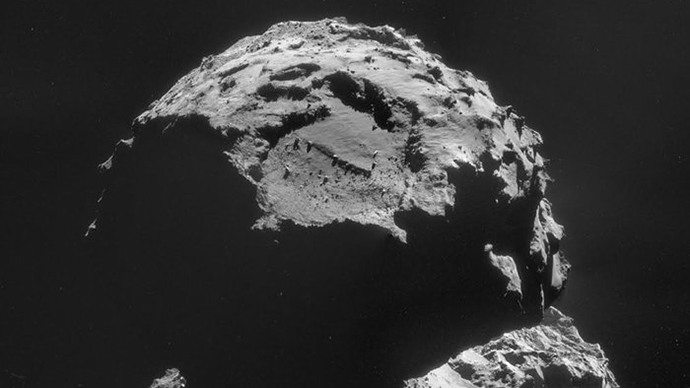A lander from the European Space Agency's Rosetta space mission is on course to descend and harpoon itself to the Churyumov-Gerasimenko comet. It has been chasing the space wanderer through the solar system for more than 10 years.
Follow RT's LIVE UPDATES on the historic landing
The agency is set to attempt the risky landing on Wednesday, with the separation of the Philae lander planned for about 09.03 GMT and touch down occurring about seven hours later, at 16:02 GMT.
The final check confirmed that all systems of the Rosetta probe are functioning properly and its Philae lander is ‘go’ for comet landing, reported ESA.
#CometLanding is on track! RT @ESA_Rosetta: Final Go/NOGO complete! We're GO for separation!!! pic.twitter.com/mBVifIog20
— ESA (@esa) November 12, 2014
On Tuesday a problem with Philae was detected, when the lander’s systems failed to log on properly at first. To avoid any possible problems ESA specialists had to reboot the module to get a proper functioning of its systems and scientific equipment on board.
"The Philae Control Team at the Lander Control Centre have completed a final check and verification of the lander’s health. The GO was given at 0235 GMT," said Rosetta's blog on ESA website.
"Following a short manoeuvre set for 0730 (GMT), the final GO for separation will be made around 0735 (GMT)," the blog added.
If successful, it will be the first time in the history of space exploration that a man-made object has made it to the surface of a comet.
Comet 67P/Churyumov-Gerasimenko is travelling through space at speeds of around 135,000 kilometers per hour, and it orbits the Sun every 6.45 years.
The Rosetta robotic probe will release the washing-machine-sized 100-kilo Philae probe from a distance of approximately 22.5 kilometers from the comet’s center.

During its 7-hour descent, the lander will take photos of the small (just four kilometers in diameter), comet and will analyze dust, gases and plasma emitted by the space object. Also, the lander will measure the presence of any magnetic field.
If the landing proves successful, it will take 28 minutes and 20 seconds for a signal from Philae, retranslated by Rosetta’s antennas, to reach the control station on Earth.
The chances of a successful landing are slim, because the surface of the comet is rough terrain consisting of craters, crevasses, cliffs up to 150 meters high and giant boulders. The one suitable landing site has been given a name – Agilkia; it’s an egg-shaped plateau measuring 900 by 600 meters.
Because the Churyumov-Gerasimenko comet is too small to have any significant gravity, the lander will attach itself to the surface using ice screws in each of its legs and fire two additional harpoons.
Philae’s scientific mission on the surface is planned to last 64 hours - the lifetime of its batteries. The probe also has solar panels that might accumulate some energy for the onboard equipment, yet this power source is unreliable since the comet’s environment is dusty.
The lander has a list of experiments to be conducted over less than three earth days before it completely runs out of power.
ESA astrophysicists expect the results of the Rosetta mission to shed light on the origins of life on Earth, as well as increase our understanding of the evolution of the solar system.
Rosetta’s sensors have already discovered that the comet has an extremely rich chemical composition, which according to human standards “stinks.”
“The perfume of 67P/C-G is quite strong, with the odor of rotten eggs (hydrogen sulfide), horse stables (ammonia), and the pungent, suffocating odor of formaldehyde. This is mixed with the faint, bitter, almond-like aroma of hydrogen cyanide,” said Kathrin Altwegg, head of the ROSINA project at the Center for Space and Habitability (CSH) at the University of Bern. “Add a whiff of alcohol (methanol) to this mixture, paired with the vinegar-like aroma of sulfur dioxide and a hint of the sweet aromatic scent of carbon disulfide, and you arrive at the ‘perfume’ of our comet.”
The Rosetta spacecraft worth $1.6 billion was launched on the ESA Ariane 5 rocket in March 2004. The probe has traveled a total of 6.4 billion kilometers to get to the 67P/Churyumov-Gerasimenko comet. On its way, it used the gravity of Mars (in 2007) and Earth (three times, in 2005, 2007 and 2009) to gain enough speed to catch up with the comet on its orbit.

